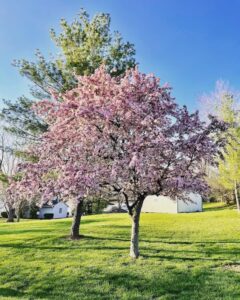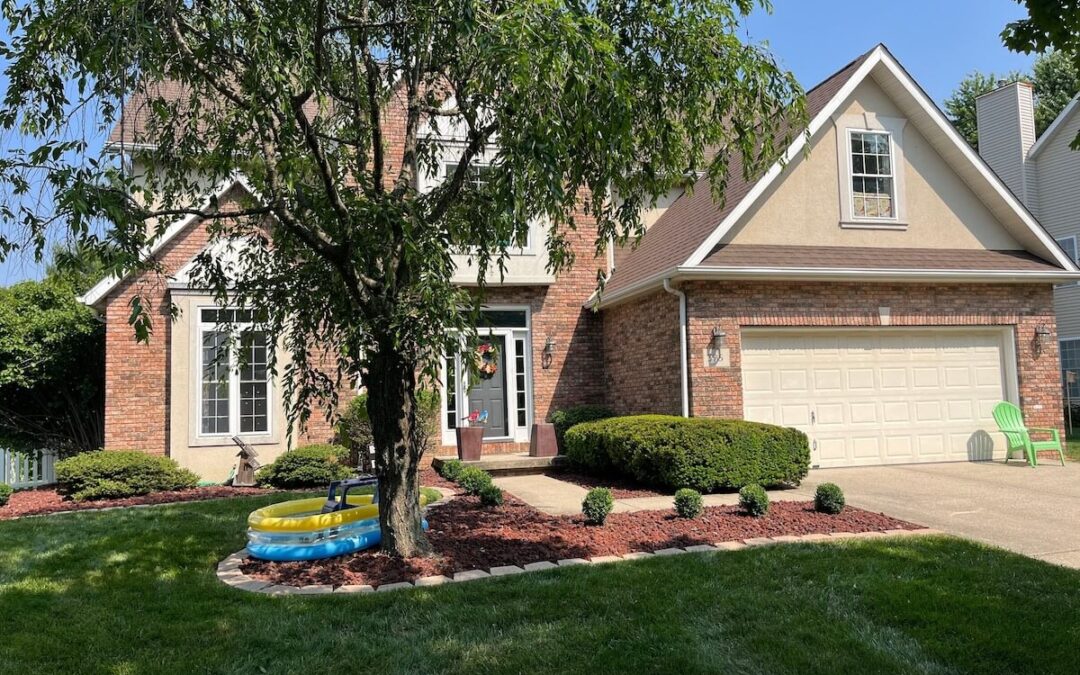Bloomington, Indiana has some beautiful urban trees. One of the most famous is the red maple, who’s leaf inspired the city seal. It turns a brilliant red color in the fall. But many other trees are found, including the star magnolia (which produces white star shaped flowers in the spring) and a variety of oaks. In fact, Bloomington was recognized as Indiana’s first Tree City USA in 1984, and has kept the designation ever since.
If you have trees in your yard, then it’s your responsibility to keep them healthy, and the city provides a tree care guide which also gives species you should avoid planting. But what if one of your trees is sick? Trees can take a long time to replace, so knowing how to save a dying tree will keep your yard shaded and is also a good thing to do.
Identifying a Dying Tree
Trees are very resilient, but they can die from sickness, age, or lack of water. Here are some signs that your tree may be in trouble:
- Bare, leafless branches sticking out from the canopy of a deciduous tree. This is a sign of root issues, and is particularly common with silver maples.
- Sap oozing from holes in the bark, unless it’s normal for the tree species concerned. If in doubt, check. If the tree is an ash, then this could be emerald ash borer, which requires immediate treatment.
- Sawdust around the base of a tree, which is always a sign something is going on.
- Fungal growths on the trunk or limbs. This indicates a decay issue inside the tree. Again, make sure this isn’t normal. Some tree species host shelf fungus as a matter of course, including black locust.
- Bark sloughing off the trunk, unless it’s a tree that sheds bark, such as crepe myrtle. Silver or white plating under the bark is a sign of hypoxylon, which also needs immediate treatment.
- Black lesions on the leaves. These aren’t going to kill a tree, but can stress it and make it more vulnerable to other issues.
- Browning or drooping branches, or scorch marks. These are signs a tree is not getting enough water or, in some cases, too much water.
- Lack of flare at the base of the trunk, which indicates improper planting and will shorten the life of your tree
- Wounds or cracks on the trunk from physical trauma, causing structural damage to the tree
- Exposed or heaving roots, which show the tree does not have enough space for a healthy root system
If you think something is wrong with your tree, it’s always worth getting a tree inspection done to see if it needs to be trimmed or removed. An expert can see how bad the problem is, treat it if necessary, and also give you good advice on how to save your tree and keep it healthy. Sometimes a tree cannot be saved.
Common Causes of Tree Decline in Bloomington
Tree decline can, as you see, come from a variety of causes. Some of them are more common in other areas than others. Here are some common causes in Bloomington:
- Emerald ash borer. This invasive Asian species has, unfortunately, been found in Bloomington. It affects ash trees, and infestations are fatal without aggressive treatment with the right insecticide. If you find holes or oozing sap on an ash tree, call an arborist immediately. The city has done a decent job of elimination. Planting ash trees, however, is not currently recommended.
- Inappropriate planting. It’s possible a previous owner planted a tree that simply doesn’t belong in Bloomington. Some trees which typically have issues are American elm, common crabapple, mountain ash, red elm, and Russian olive. If you are planting trees, look first to species native to Indiana, which include Yellowwood, Kentucky Coffeetree, and White Oak. Native trees are more likely to thrive. Also, trees may be planted in areas where there is not enough space. Ask for an arborist’s advice on how large a tree you should plant.
- Soil compaction. This often affects urban trees and reduces the space the tree has to grow a healthy root network.
- Air pollution. This impacts all urban trees. Trees can also reduce pollution, but pollution stresses them and makes them more vulnerable to insect pests.
- Oak wilt. This is a fungal disease that affects oak trees and can also be fatal. It causes leaf discoloration and wilting.
- Anthracnose. Another fungal disease, which affects oak, maple, and ash trees. This causes dark lesions to form on the leaves and can lead to leaf loss. It’s not fatal on its own, but can make the tree more susceptible to other diseases.
DIY Steps to Revive A Tree
So, if you have a sick tree, how can you help it? First of all, make sure that you are up-to-date on basic tree care. Many trees do need to be watered, and they need a lot of water. Pay particular attention to your trees when summer gets hot and dry, as they can easily get dehydrated. Even a tree that normally survives on rainwater may need some extra help come August.
Trees also benefit from pruning. Pruning can also deal with issues where a shade tree is shading something too much, or where a tree is getting too close to power lines. If you aren’t up to pruning the tree yourself, you can hire a professional.
You should mulch your trees in the winter before first frost and then the spring after the last frost. Mulching when the ground is frozen will not benefit your trees.
A tree that is stressed will benefit from fertilizer. One thing that can really help a stressed tree is fertilizing in the fall. Apply the fertilizer as soon as the tree drops their leaves, using nitrogen fertilizer spread evenly on the ground in the root zone, and then water. If your tree is in the middle of a lawn, fertilize the entire lawn, or you will get a zone of faster growing grass around the tree.
Improve your soil health in general by increasing the variety of plants in your yard and planting native plants.
When To Call A Professional

Always call a professional if you suspect emerald ash borer, oak wilt, or hypoxylon (silver or white under sloughing bark). All three of these can be fatal to your tree if not professionally treated.
Also consider calling a tree professional if:
- You have a large tree and are uncomfortable pruning it yourself. If climbing the tree is needed, leave it to the experts
- You aren’t sure what is affecting your tree and want an expert diagnosis
- You just need some advice. We’re always happy to help you and your trees.
Always call an expert if removal is needed. We don’t remove until we have to, but you should not try to remove a tree yourself, even a fairly small one. You don’t need a permit to remove a tree on your own land in Bloomington.
Preventative Measures to Keep Trees Healthy
The best preventive measure is to ensure your trees get the right amount of water. You may need to water them routinely, or at certain times of year. Native trees generally need less help. Young trees should be watered for at least the first three years. Trees should be watered thoroughly every five to 10 days from April to October, unless it has been raining heavily.
Consider mulching in spring and fall. Use light wood mulch. Check with an arborist if you aren’t sure whether your tree needs mulching. Some thin-barked trees benefit from wrapping during the winter, with special paper tree wrap material. An arborist can help you find this.
Get professional tree assessments regularly to help spot anything you might have missed.
If you have a sick or dying tree, it needs help right away. For certain pests, you should always call an arborist. Otherwise, you can help a sick tree with fertilizer and extra (or less) water. If in doubt, contact Anthony’s Tree Removal for expert tree service and assessment.


Recent Comments